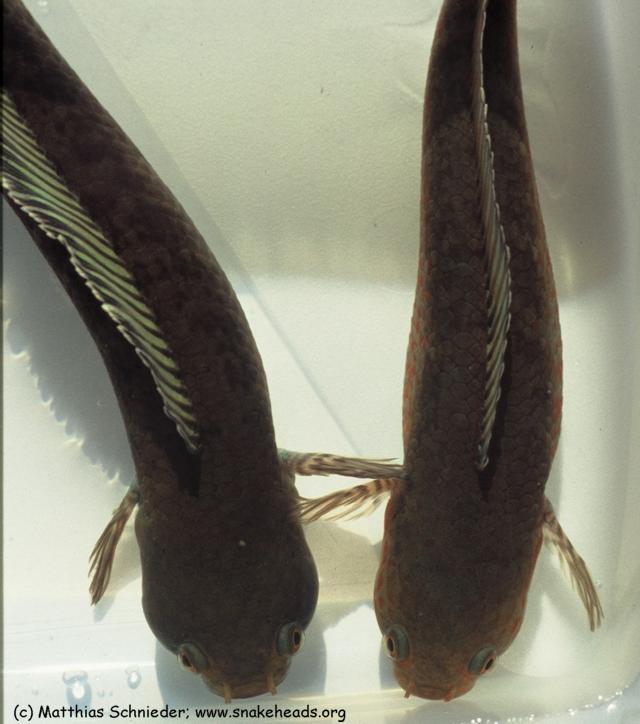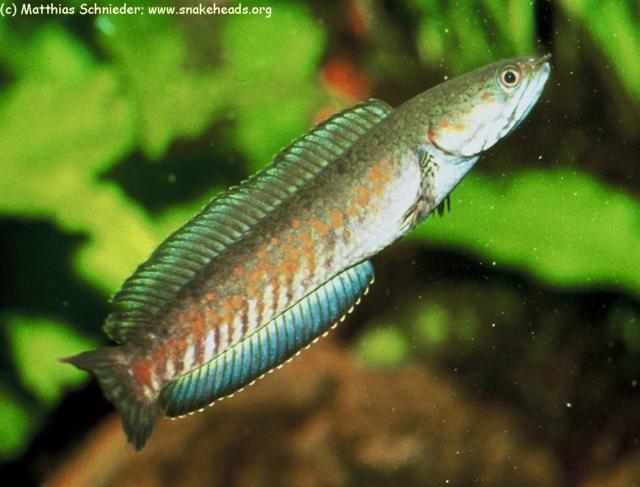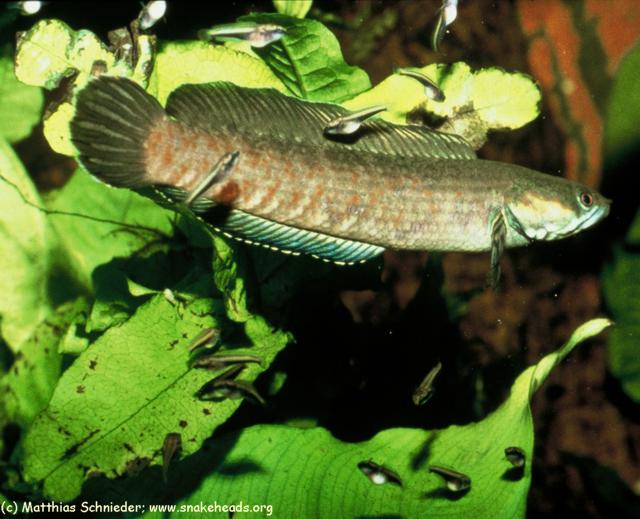
When in 1777 Scopoli described channa in one of his scientific works 1 , nobody knew how extraordinary this species is.
In India, their tough mucous of these so-called snakehead fishes was used as glue in the construction industry. And ever since, snakeheadfish has been a delicacy in Asia as well as in Central Africa where it can be found at local marketplaces. Nevertheless, the Channidae are still largely neglected in the field of aquarium fish. The almost forty species are separated in two genera covering two continents. The genus channa is found in Asia, and the genus Parachanna is found in Africa. It is rare to find any literature on them, let alone detailed reports of succesful breeding.
The reason for this fact is probably their bad reputation. Most aquarists consider snakehead fish to be big (more than a metre long) bad guys in large show tanks. In reality, it is very different. Some species are less than 20 cm (8 in), a handy length. Many species are very colourful and prettier than the most freshwater fishes. Like the labyrinth fish, they have an additional breathing organ, the socalled suprabranchial organ, which makes them real survival artists. It is no wonder that snakeheads can be found in oxygen-deprived swamps, canals, and heavily polluted waters. In other words, they are hardier than most aquarium fish species. Nevertheless, there are some important steps to be taken in keeping and caring for snakehead fish. ToC
One problem with keeping snakeheads is the tank size. Some species can become enormous. The larger species, such as parachanna obscura or channa stewartii should have a tanks of at least 1,5 m (59 in) to 1,8 m (70 in) in length. The giants should be kept in large show tanks of size 2 to 4 metres (79 to 158 in). Only the smaller species can be satisfied with 1-metre tanks. These measurements should only be regarded as general guidelines for keeping several individuals. One must also take into account the aggressiveness, the swimming activity, and other characteristics of the species. Although the swimming of all species decreases rapidly with age with increasing age (older fish often spend their time lying on the ground), a tank shared by several individuals can never be too big. Even harmonizing couples can have wild fights which can end in the death of a partner, if the tank is too small and the channa keeper does not intervene in time.
By and large, snakeheads are not bothered by water chemistry. One can keep them in any water that could be used for cooking or dringking. Water hardness and ph value are not critical factors; the only precaution is to avoid alkaline is or very hard water. To keep in mind, however, is that large individuals consume large amounts of protein and have a correspondingly high metabolism. The excrement places a heavy strain on the water the water by increasing the amount of nitrogen compounds (ammonia, ammoniac, nitrite, nitrate), which are toxic for fish or decreases their vitality over time. The negative effects of nitrogen compounds, however, are less felt by snakeheads than by other aquarium fish. A regular partial exchange of the tank water (every two weeks) helps to combat the decrease of the decrease of the water quality. The ideal temperature depends on the origin of the species.
Snakeheads are generally considered to well-behaved aquarium decoration, neither grubbing nor causing harm to plants. But, during breeding they dig holes and remove plants which 'stand in their way'. Therefore it is recommended that the tank be decorated with with large stones, roots, and a dense collection of plants around the edges of the tank. Fine-stemmed plants, as well as light ground should be avoided. A better solution is to use coarse sand, which for example, can be shaded with foliage or covers of swimming plants. This is close to their environment of their natural habitat. Some species love to hide beneath swimming wood to wait for their prey. A paludarium decorated with large roots hanging down into water is ideal for these types. In the wild, during the early morning hours I have observed snakeheads lying in the sunlight just below the surface (some kind of warming up for the day?). In captivity, however, the fish seem to be more at ease in dark tanks, so that strongly lit aquariums should be darkened by means of swimming plants or wood.
With respect to food, snakeheads are considered to be trouble-free predators. With a little bit of patience and a lot of skill, most species can be made to get used to nearly all kinds of substitute food as long as it is of animal origin. But one must be careful not to feed them too much mammal's meat (and surely not exclusively mammal) because it strains their digestive tract. This consideration also goes for fatty meat. It is optimal to have a varied menu. Here is a small excerpt of a snakehead's menu: feeder fish, heartof beef, earthworms, mealworms, coarse frost food (mosquito larvae), insects (including maggots), trout pellets.
One important thing to note is that snakeheads are extraordinarily good jumpers, and have a very strong urge to leave the tank, especially during the adjustment period when they are in a new environment. To this end, they will seek out even the smallest cover's hole to try to flee. Unfortunately, this leads too often to their death, and is indeed their most common death reason. ToC
Although very little is known generally about the reproductive behaviour and the breeding of snakeheads, it is commonly assumed that all species are brooding egg-layers. There are probably some species in which the brooding is taken over exclusively by the male. But most species are assumed to form parental families like the few mouthbrooding species. These are channa gachua, channa orientalis, and the lately discovered channa spec. 'Assam' (which often is mistakenly called ' blue bleheri '). Channa bleheri is no mouthbrooder!
Channa gachua and channa orientalis have developed a special strategy to feed their brood high quality food, through the release of feeder eggs! Some facts indicate that it could be the same with channa spec. 'Assam', but I could not (yet) observe this. 2
 | A male C. spec. Assam. It differs from the female in having less red scales, more metalic blue color in the unpairy fins, and having a broader head. |
Nevertheless, in this article I intend to present a comparison of this three species as well as their extraordinary reproductive behaviour.
Channa gachua is the most widely distributed snakehead. It could be found, from West to East, in Iran, Pakistan, India, Sri Lanka, Bangladesh, Myanmar, Thailand, Malaysia, Cambodia, Laos, and Vietnam up to China, Tawain, as well as down to Indonesia (but no further than Bali).
Channa orientalis is a genuine endemic species on Sri Lanka, i.e. it only exists on this one island.
The habitat of channa spec. 'Assam' is the Indian state Assam and probably bordering states.
All the species prefer streaming waters as for example mountain streams, small rivers, jungle streams. But I also was able to find channa gachua in oxygen-deprived wastewater ponds in Rayong (Thailand), in which all life seemed to be extinguished. There, it lived up its reputation of a tough survivor.
These three species belong to the smallest of their kind. Channa gachua can reach 20 cm (7.88 in) which is depending on their geographic origin, but are usually much smaller. 3 Channa orientalis is not larger than 16 cm (6.3 in). But channa spec. 'Assam' is the smallest. I started breeding them when they reached a size of 9 to 10 cm (3.5 to 3.9 in), thereafter I could observe no further growth.
The breeding of this mouthbrooders is relatively easy, provided one has a harmonizing couple. Pairing should be allowed to occur naturally within a group, otherwise complications might arise as the sey of the fish is often difficult to determine. During breeding season, females are fuller than the males because of the spawn. The sex differences of channa spec. 'Assam' can be determined relatively well by comparing the individual from bird's eye view. The male' s head is broader, especially in the gill area. The female's body color contains more red and her fins are not as blue as the male's. Determining the sex of the fish by comparing head forms also works well for channa bleheri. I suspect the same to be true for channa orientalis, and channa gachua, as well as for their close relatives. 4
 | A couple of C. spec. Assam. Left hand the male with its broader head and its more colorful dorsal fin. Right hand, the female whose head is not so broad but its belly. |
If there is a harmonizing couple, one can expect the brood soon. A 120-litre tank (25 gl) should suffice a well harmonizing couple, whereby surface area is more important than aquarium height.
Many aquarists still assign channa to the labyrinth fish (anabantoidei). Tyson Roberts' hypothesis concerning the close kin and common origin of both groups of fishes is disputed. But the resemblance of their mating behaviour is undisputed. Copulation occurs during an embrace in which the male wraps himself around the female's stomach area. A few days before spawning, the couple has more and more skin contact. There follow several pseudo-copulations, which serve to perfect the timing of the actual mating. Finally, there is one long and intense embrace during which all the necessary sexual products are discharged. The eggs are oily, so that they slowly rise to the water's surface, where the male partner takes them into the mouth. In the mouth, the eggs are securely guarded.
 | A female C. spec. Assam. It differs from the male in having more red scales, less metalic blue color in the unpairy fins, and having a broader belly. |
Up to this stage, the process of pairing is the same for all the three species. But there are several important differences concerning the kind and the length of the care. For comparison purposes, I have listed them in the table below.
| Differing Aspect | channa gachua | channa orientalis | channa. spec Assam |
| Release of the hatchlings from the mouth | after 3 days | after (about) 8 days | after 2 to 3 days |
| The number of the fry | about 200 | below 50 5 | below 65 6 |
| First air breathing on the surface | about 6 days after their release into the water, i.e. about 9 days after pairing | about 10 to 12 days after their release into the water, i.e. about 20 days after pairing | about 10 days after their release into the water, i.e. about 13 days after pairing |
| Living pattern of the fry | swimming freely after 7 days as a close group | living closer to the ground. Possible reason: living in mountain streams | firstly living close to the ground, and after 6 to 10 days swimming freely, only in lockerem Zusammenhalt |
| Behaviour of the fry and the parents | the parents weak in the function of leading, rather they follow their fry. | close body contact to the parents, especially to the mother | close body contact to the parents, especially to the father, the primal guard of the brood. |
From the table, one can clearly see the differences of this three species in respect to reproduction, whereby channa spec. 'Assam' shows many parrallels to channa orientalis. Channa orientalis was also the species about which a sensational, at that time still ichthyologically unknown discovery was made in 1986. As already mentioned, the fry maintain close physical contact with the parents. In the moment in which the fry touched the mother's body, she released a large number of eggs in a rotating movement. These eggs were not oily, and would began to sink rapidly. However, before they could reach the bottom, the eggs were greedily devoured by the fry. The young only rested once they were sure that the last feeder egg had been eaten. 7 Such a behavior was also observed bei channa gachua.
 | A male C. spec. Assam guarding his hatchlings. Hatchlings must be put separate after they get about 2 cms. Then they are seen as food. |
In how far this is valid for channa spec. 'Assam' is (still) unknown. There are, however, indications that support this hypothesis.
In a trial, I was able to observe the following: two weeks after hatching, I had separated half of the breed from their parents and placed them into 54-litre (16 gal.) tank. Up to this point, the whole brood seemed to be well fed, althoug I had given the young no special food, only large amounts to the parents. (Why were the young nonetheless well fed?) After ten days I reunited the brood and stared in amazement at the differences in size of both groups. The hatchlings that have remained with their parents in the 160-litre (47 gal.) aquarium were predominantly double the size of their siblings. And this although I neither changed water nor fed the remaining ones specially. On the contrary the parentless fish were covered in live food and the water was changed constantly. Similar experiments with channa gachua and orientalis resulted in exactly the same outcome. 8
Unfortunately, those 'experiments' with snakeheads are rather the exception than the rule and therefore their reporting is accordingly rare. I do not begin to assume that this report will trigger a channa-boom, but maybe I have inspired the one or the other aquarist with the penchant for the extraordinary. ToC
1 Scopoli is the one who is accepted to have introduced the name of the genus, though it was introduced by someone else. Back
2 A different author for breeding channa bleheri suspects them to feed its brood also with feeder eggs. See here for the article. Back
3 Dr. G. Ettrich reported snakeheads.org that the largest channa gachua can be found on Bali and the smallest in Myanmar. Back
4 Dr. G. Ettrich reported snakeheads.org considering the sex differences that he himself cannot determine the sex of c. orientalis when they are in juvenile state in which they are already sexual mature. Only when they are adult he might determine female ones because of the spawn. Back
5 Dr. G. Ettrich reported snakeheads.org that he could breed in the year 2002 a couple of channa orientalis whose fry resulted in an amount of more than 200. The couple was caught by a member of snakeheads.org. It was not older than 18 months. Dr. Ettrich said he had neither heard of a larger amount nor had he achieved a larger number. Back
6 Due to another report, the number was 136. Back
7 The author refers to the discovering of Dr. Ettrich which was described by him in: Ettrich, G. - Fische voller Überraschungen. DATZ 86/7 pp. 289-293. This article is in German you can find the English pendant here. Back
8 Those result have also been reproduced with channa bleheri. To read about it go here. Back
This is an original manuscript of an abridged German article which was published in: Aquaristik Fachmagazin, No. 162, vol. 33(6) - Eier fütternde Schlangenkopffische. The author has granted snakeheads.org the right to publish it on the org's site. The translation has been done by snakeheads.org, proof reading was done by Nadine Anderson. The photos are taken by the author. The copyright of text and photos is still with the author/photographer in full amount. The author can be reached through the email address given above. Thank you Matthias!
| © 2001 - 2003 snakeheads.org | HOME of this page |